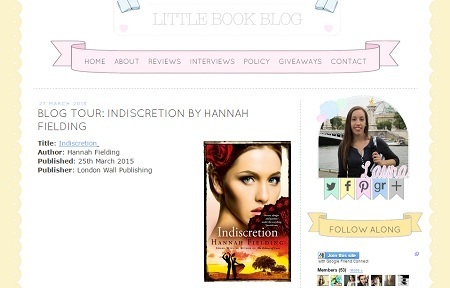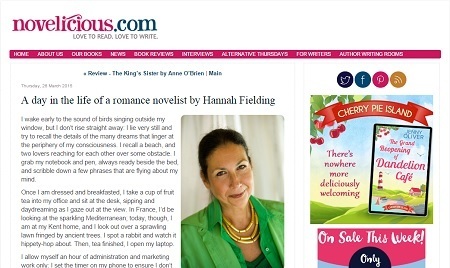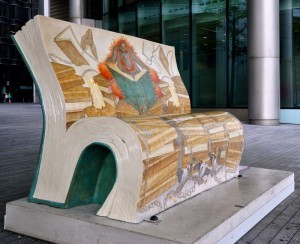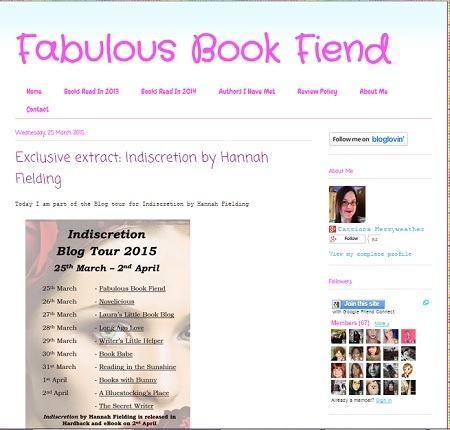Hannah Fielding's Blog, page 87
March 27, 2015
Indiscretion Blog Tour: Q&A with Laura’s Little Book Blog
Today you can find my online at http://lauraslittlebookblog.blogspot.co.uk/2015/03/blog-tour-indiscretion-by-hannah.html, sharing, among other things, why I so love masked balls.
March 26, 2015
Indiscretion Blog Tour: ‘A Day in the Life’ with Novelicious
Today I’m hosted by the wonderful Novelicious, and I’m sharing what it’s like to be a romance writer: http://www.novelicious.com/2015/03/a-day-in-the-life-of-a-romance-novelist-by-hannah-fielding.html
Indiscretion Blog Tour: Read an extract at Fabulous Book Fiend
Head over to Fabulous Book Fiend today and you can read an extract from my soon-to-publish book, Indiscretion… http://fabulousbookfiend.blogspot.co.uk/2015/03/exclusive-extract-indiscretion-by.html
March 25, 2015
Starting today: The Indiscretion Blog Tour…
The flamenco arts
 When I write a novel, I immerse myself in the culture of the setting. For Indiscretion, set in Andalusia, Spain, that was an absolute pleasure, for it meant many hours enjoying one of my favourite art forms: the flamenco.
When I write a novel, I immerse myself in the culture of the setting. For Indiscretion, set in Andalusia, Spain, that was an absolute pleasure, for it meant many hours enjoying one of my favourite art forms: the flamenco.
The flamenco originated in Andalusia in the eighteenth century, and it is the dance of the gitanos (Romani people of Spain). It has two main facets:
The movement: This includes the baile (dance),the palmas(handclapping) and pitos (finger snapping).
The music: The cante (singing) and toque (guitar playing).
What is striking about flamenco is how it draws in both performer and spectator – indeed, there is no such thing as an onlooker; when you are close to a flamenco performance, you are in that performance: you cannot stay still and silent. See, for example, how collaborative the artists are in this flamenco sung by Estrella Morente:
In addition to the music and movement elements of the pure flamenco, a whole culture exists around it:
Gatherings like the juergas – informal, spontaneous meetings such as the gypsies hold in my book Indiscretion – through to professional performances. Even abroad flamenco has its place. The famous Sadler’s Wells in London, for example, teaches its students the flamenco and holds a world-renowned Flamenco Festival.
Poetry inspired by the movement and music. In Houston, for example, there exists the Flamenco Poets Society that is ‘dedicated to promoting an appreciation and understanding of Latin American & Spanish poets and the Flamenco Arts’.
And, of course, the most beautiful costumes. Did you know that fashion designers in the 1950s were particularly inspired by the flamenco? Here’s an example of a dress designed by Michael Sherard that I once saw at an exhibition at London’s Victoria and Albert Museum: http://www.vam.ac.uk/users/node/17260.
Flamenco has become not only a symbol of the Spanish passion but also a very popular dance worldwide. In Japan there are more flamenco academies than there are in Spain! What is the draw? It comes down to the emotion that is incarnate in the art form, I believe. Flamenco is about love, and it is about loss, about death. ‘Why couple these two most important experiences of life?’ my heroine Alexandra asks in Indiscretion. Salvador’s response is as follows:
‘Spanish flamenco is the embodiment of passion. Some people say that music is at its best when wild and unleashed. Flamenco is often like that, heels stamping, castanets clicking, skirts of the dancers whirling. But a singer may sing a sad love song. Flamenco, and especially Andalucian flamenco, is a force of nature … like love. The singer reaches deep down into his soul and that is what makes the notes so, as you say, poignant.’
I will leave you with a beautiful example of a flamenco dance by Celina Zambon. Oh, to dance like that!
March 23, 2015
Respect for romance: signs of change
I have written before on my blog about the poor reputation of romance as a fiction genre. It’s simply not as respected as many other genres, and neverhas been. But there are signs of a change in the wind.
According to an article in the Smithsonian magazine:
‘[A] new breed of literary scholars… are throwing open the velvet curtains behind which romance fiction has long been cloaked (or these days, behind the leather pages of Kindle cases), turning their highbrow spotlight on one of the most popular and underrated lowbrow pastimes (a genre so beloved that it is often pegged for floating the publishing industry—more than half of the mass market paperbacks sold in the US are popular romance novels).’
There is now an International Association for the Study of Popular Romance, together with an academic journal, The Journal of Popular Romance Studies,which has published on subjects as diverse Nora Roberts, and disability and romance in vampire fiction. There is talk of a graduate prorgamme. Recently, there was a conference at the Library of Congress entitled ‘What is Love?’. And a new documentary project, Love Between the Covers, is taking ‘its viewers into the multi-billion dollar romance fiction business and the remarkable worldwide community of women who create, consume, and love romance novels’. The filmmaker Laurie Kahn told Emma Pearse for the Smithsonian:
‘The stereotype has been overweight women eating bonbons in bed, reading alone. The truth is that people from every conceivable socioeconomic background are reading this fiction. And the authors are surgeons, lawyers, professors.’
Meanwhile, dedicated bodies the Romantic Novelists’ Association in the UK and the Romance Writers of America continue to do great work to promote romance fiction and support writers and readers, and conventions are increasingly opening up for the romance genre as well, such as RomCon and the RTBooklovers’ Convention.
The verdict? Change is afoot, and it’s a very good time to be a romance aficionado. No longer will we be ‘hopeless’ romantics…
March 21, 2015
Favourite writer: Miguel de Cervantes– an addendum
Recently, I blogged about one of my favourite Spanish writers, Miguel de Cervantes, who penned the wonderful novel Don Quixote. In my post, I noted that he was buried in an unmarked grave and an initiative was launched to trace his remains.
Just a few days later, I read in the news that scientists believe they have found the bones of Cervantes, his wife and others recorded as buried with him in Madrid’s Convent of the Barefoot Trinitarians. Details of the archeological find are online here: http://www.bbc.co.uk/news/world-europe-31852032.
How wonderful for Spain, to be able to honour this ‘Prince of Letters’ at last.
March 20, 2015
Inspiration for writers from the late, great Sir Terry Pratchett
 I was saddened to read of the passing of Terry Pratchett last week. While fantasy is not one of the genres I choose to read, I respected his writing – his craft, his ethos and his work ethic – greatly, as did so many others. After the publication of his first Discworld novel in the early 1980s, he wrote on average two books per year, and their popularity is clear in the sales figure: 85 million books worldwide in 37 languages.
I was saddened to read of the passing of Terry Pratchett last week. While fantasy is not one of the genres I choose to read, I respected his writing – his craft, his ethos and his work ethic – greatly, as did so many others. After the publication of his first Discworld novel in the early 1980s, he wrote on average two books per year, and their popularity is clear in the sales figure: 85 million books worldwide in 37 languages.
The literary world is mourning the loss of such a talented and prolific writer. But as Terry himself wrote, ‘No one is actually dead until the ripples they cause in the world die away.’ As well as his legion of fans, who will continue to buy, to read and to pass on his novels, Terry’s work can inspire many generations of writers to come. With that in mind, today I’m sharing with you three lessons to learn from Terry’s writing, which were common themes that cropped up in his responses to interviewers over the years.
Trust the muse
Infamously not one for planning, Terry was very open about sitting at his computer and letting the words form on the page without his interference. Now, I write very differently, planning my books in detail before commencing the writing, but at the beginning of my own process, I know to let the ideas come unhindered – the editing comes later. What really comes forth in Terry’s interviews is how much he loved the initial writing stage when he and the muse were at one. He said: ‘when I am editing, rewriting, refining and polishing my work, I say to myself: “If you’re a good boy and finish this before the deadline, you’re going to be allowed to write another book!”’
Do your homework
‘To writers I say, you’re going to have to read a lot… So many books that you’re going to overflow.’ There is no better advice for writers, to my mind. He told Writing Magazine, ‘To write good SF and to write good fantasy, like anything else, you have to have actually studied it. Not just thought, ooh this looks good, I know how it goes. You have to know what works. You have to know what’s gone before. You have to know how Poe wrote, how everybody wrote. You have to read Brian Aldiss. But you have to read everybody, not just the SF guys. It’s just following the masters. See how the best are doing it.’I think when you approach writing in this way, as a student of the craft, humble in your desire to learn, your ultimate writing is infinitely better.
Practise every day
He told young people seeking his advice on how to become a writer to write 500 words a day, every day: no excuses. That equates to 182,500 words per year – around two novels.
Put in the hard work
Writing is hard, he said. It takes a lot of hours and a lot of hard work. ‘[People] think it should be easier than that,’ he said in an interview.‘It’s not easier than that… But people don’t want to be told that they have to sit there for a long time and work hard at it.’ He talked about some people’s desire to ‘have written’ rather than to actually write. Thank goodness for his realism about what it is to be a writer, about how many arduous hours you spend writing. And thank goodness for us all that he consistently put in the hard work, because now we have so many wonderful, colourful, funny books he has left as his literary legacy.
March 18, 2015
The growing popularity of audiobooks
 A recent report by children’s publisher Scholastic found that while parents often stop reading aloud to children once they can read independently, many children up to the age of eleven wish their parents would continue. Reading with a parent is, of course, quality time, but I think the reason also comes down to the joy of hearing a book read aloud.
A recent report by children’s publisher Scholastic found that while parents often stop reading aloud to children once they can read independently, many children up to the age of eleven wish their parents would continue. Reading with a parent is, of course, quality time, but I think the reason also comes down to the joy of hearing a book read aloud.
Storytelling is an art form that dates back as long ago as the formation of speech. But for so many years it was purely oral. So you may say it is in our blood to enjoy a story told aloud – we are programmed, like our predecessors, to sit at the fireside and listen avidly to a story that is not only a good tale, but also one that is told well enough to hold our interest.
Until the digital revolution, audiobooks were not widely popular. They came in large, clunky plastic cases full of cassettes – and then, finally, CDs. Many associated them with the elderly and those with visual impairment. They didn’t have quite the panache of the paperback or the serious weightiness of the hardback.
But then digital as a medium crept into the market, and exploded. People began to demand that technology offer more ways to engage with all manner of cultural things – art, music, theatre, film and, of course, books. Much has been written of the ebook. But alongside the development of the ebook, the audiobook has gone from strength to strength.
Audible became a frontrunner in changing the reputation of the audiobook and working to widen its consumer base. To date, it has amassed 150,000 audio programs from audiobook publishers, as well as broadcasters, entertainers, magazine and newspaper publishers and business information providers, which amounts to more than 1.5 million hours of listening. So successful did Audible become that it was bought by Amazon in 2008.
Why the growing interest in stories told aloud? I think several reasons exist:
Audiobooks are more readily available than ever, via various means. You can buy a CD, for example, or you can access the book on a pay-per-month platform like Audible. You can even, via Whispersync for Voice, switch between reading a book on the Kindle and listening to it as an audiobook.
As more and more publishers go audio, a wider range of books is available, making it a viable format for many listener-readers.
They’re more in vogue than ever. Those who can read now sometimes choose to listen instead.
The pace of life has picked up, which can make fitting in the time to sit and read a book more difficult. Audiobooks allow one to multitask – ‘reading’ while commuting to work on the train, for example; thereby giving eyes overloaded with digital information from phones, tablets, computers and so on a much-needed rest.
Production has become even more professional. Some of the narrators are just wonderful, and so much thought goes into making the book. Here, for example, is the narrator of the audiobook for my novel The Echoes of Love (actor Matt Addis) sharing a little about the process:
The future, then, for audiobooks is bright indeed, with ever-more innovative initiatives being rolled out to entice new readers to the medium. Audible, for example, has launched the ‘Stories that Surround You’ campaign in an attempt to bring onboard new, younger readers. It has created a brilliant video showing the joy of immersion in a story world via oral storytelling. I love the blend of the real world with fantasy: it really conveys what it is to be a book lover.
My books The Echoes of Love and Indiscretionwill be available as audiobooks soon. Watch this space for news!
March 16, 2015
The Moors of Spain
 Moorish culture and legacy echoes through my new novel, Indiscretion, which is set in Andalusia, Spain, 1950, from the architecture of places that Alexandra visits to the princess costume she wears to a masked ball. Today, I take a look at the Moors of Spain, and why their influence has stood the test of time.
Moorish culture and legacy echoes through my new novel, Indiscretion, which is set in Andalusia, Spain, 1950, from the architecture of places that Alexandra visits to the princess costume she wears to a masked ball. Today, I take a look at the Moors of Spain, and why their influence has stood the test of time.
The Moors first came to Spain in the eight century AD when an army crossed the Strait of Gibraltar from northern Africa. The Moors, as they came to be known, conquered the country, and ruled it for some 800 years. During that time, they built a rich civilisation which shaped not only Spain as we know it today but also elements of the modern world:
They pushed forth scientific progress in the fields of astronomy, chemistry, physics, mathematics and geography, and their philosophical tradition was strong.
They introduced many new crops: orange, lemon, peach, apricot, fig, sugar cane, dates, ginger, pomegranate, saffron, sugar cane, cotton, silk and rice.
Ingredients introduced by the Moors, such as saffron, apricots, artichokes, carob, sugar, aubergines, grapefruits, carrots, coriander and rice, remain popular in Spanish and Andalusian cuisine. The Spanish dish paella, for example, would not exist but for the Moorish influence.
They pioneered public libraries. In the tenth and eleventh centuries these did not exist in any European country but Spain, which had no fewer than seventy.
The Arabic language was absorbed into the Spanish one, so that more than 4,000 Spanish words have their origins in Arabic, such as algebra, alcohol, chemistry, nadir, alkaline, checkmate, influenza, typhoon and orange.
While wider Europe had only two universities, the Moors established seventeen, and they extended education to all.
The introduction of paper in Europe and of the Arabic numerals we use today has been traced back to the Moors.
To bridge the distance between cities, they established towns and villages with interconnecting roads. Many of the alcazabas (citadels), fortalezas (fortresses) and castillos (castles) they constructed can still be seen today.
At the pinnacle of their rule, the centre of the Moorish land in Spain (known as Al-Andalus) was the city of Córdova, and it was astonishingly modern compared to all other cities, with paved streets, pavements and streetlamps well before any other city had these, and some 900 public baths.
While their counterparts in countries like France, England and Germany lived in draughty and gloomy dwellings, the Moors built beautiful palaces for their leaders, like the Alhambra in Granada, still celebrated today as an architectural masterpiece.
Their influence on Spanish culture was great. One such example is in the La Mezquita (pictured). It began life as a Catholic Christian church built on the ruins of a Roman temple dedicated to Janus, but the Moors turned it into a site of worship with a Muslim and a Christian half each. The two faiths shared La Mezquita for decades, and then the Moors took over and built a vast mosque on the site. Once the Moors were ousted, it was reconverted to a Roman Catholic church – and since that time Muslims have been denied the right to worship there. A much contested site, then, but a beautiful one.
If you’re interested in learning more about the Moorish influence, here’s a link to a Channel 4 documentary entitled ‘When the Moors Ruled Europe’ which I found very illuminating: http://www.bettanyhughes.co.uk/when-the-moors-ruled-europe.







